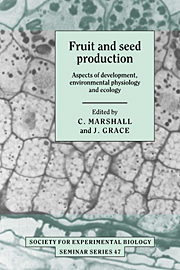Book contents
- Frontmatter
- Contents
- Contributors
- Preface
- Plant reproductive biology: an overview
- The environmental control of reproductive development
- Pollination and fertilization in higher plants
- Embryogenesis
- Environmental and internal regulation of fruiting, with particular reference to Cox's Orange Pippin apple
- Fruit growth and sink strength
- Control of grain growth and development
- The regulation of maternal investment in plants
- Ecological and physiological aspects of reproductive allocation
- Are the distributions of species determined by failure to set seed?
- Edible fruits in a cool climate: the evolution and ecology of endozoochory in the European flora
- Index
Plant reproductive biology: an overview
Published online by Cambridge University Press: 04 August 2010
- Frontmatter
- Contents
- Contributors
- Preface
- Plant reproductive biology: an overview
- The environmental control of reproductive development
- Pollination and fertilization in higher plants
- Embryogenesis
- Environmental and internal regulation of fruiting, with particular reference to Cox's Orange Pippin apple
- Fruit growth and sink strength
- Control of grain growth and development
- The regulation of maternal investment in plants
- Ecological and physiological aspects of reproductive allocation
- Are the distributions of species determined by failure to set seed?
- Edible fruits in a cool climate: the evolution and ecology of endozoochory in the European flora
- Index
Summary
Biological principles of fruit and seed production
The life cycles of flowering plants can be generalized, with a few exceptions in which sexual reproductive capacity has apparently been lost to clonal vegetative reproduction or distorted by such devices as apomixis (Fig. 1). Within this simple framework, however, the variation is enormous: the duration of the life cycle may range from days to centuries, and the proportion of the biomass invested in reproduction varies with species, genotype, age of the plant and environmental conditions (Baker, 1972). For a given reproductive investment, species may trade off large numbers of tiny seeds from a single flower, as in many orchids, as against a few bulky seeds with large reserves from a large number of flowers, as in the pome fruits. There is abundant evidence that the evolution of these details of plant reproductive biology has been influenced by a wide variety of physical factors such as availability of nutrients, light and water (Mooney, 1972) and biological factors such as the nature, availability and energetics of pollinators (Heinrich, 1975), the agents of fruit and seed dispersal (Gautier-Hion et al., 1985) and the activity of pathogens and predators (Janzen, 1977). One may trace in the literature of plant reproductive biology a process of gradual description and elucidation of factors which may influence reproductive behaviour (Lloyd, 1980; Lloyd, Webb & Primack, 1980; Sutherland, 1986; Primack, 1987; Stephenson, Devlin & Horton 1988) and a steadily increasing sophistication in the ‘telling of adaptive stories’ which purport to ‘explain’ observed behaviour (Gould & Lewontin, 1979).
- Type
- Chapter
- Information
- Fruit and Seed ProductionAspects of Development, Environmental Physiology and Ecology, pp. 1 - 8Publisher: Cambridge University PressPrint publication year: 1992



